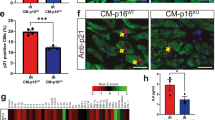Abstract
Many cardiac aging studies are performed on mice first and then, due to difficulty in mouse cardiomyocyte culture, applied the rat neonatal cardiomyocytes to further determine the mechanisms in vitro. Now, the technological challenge of mouse cardiomyocyte culture has been overcome and there is an increasing need for the senescence models of mouse cardiomyocytes. In this study, we have demonstrated that the senescence of mouse cardiomyocytes occurred with the extended culture time as shown by the increased β-galactosidase staining, increased p53 expression, decreased telomere activity, shorted telomere length, increased production of ROS, increased cell apoptosis, and impaired mitochondrial ΔΨm. These senescent responses shared similar results in aged mouse heart tissues in vivo. In summary, we have established and characterized a novel senescence model of mouse cardiomyocytes induced by the extended culture time in vitro. The cell model could be useful for the increased cardiac aging studies worldwide.

Similar content being viewed by others
References
Dai, D. F., Chen, T., Johnson, S. C., Szeto, H., & Rabinovitch, P. S. (2012). Cardiac aging: from molecular mechanisms to significance in human health and disease. Antioxidants and Redox Signaling, 16, 1492–1526.
Lara-Pezzi, E., Menasché, P., Trouvin, J. H., Badimón, L., Ioannidis, J. P., Wu, J. C., Hill, J. A., Koch, W. J., De Felice, A. F., de Waele, P., Steenwinckel, V., Hajjar, R. J., & Zeiher, A. M. (2015). Guidelines for translational research in heart failure. Journal of Cardiovascular Translational Research, 8, 3–22.
Flister MJ, Prokop JW, Lazar J, Shimoyama M, Dwinell M, Geurts A; International Committee on Standardized Genetic Nomenclature for Mice; Rat Genome and Nomenclature Committee. (2015). 2015 Guidelines for Establishing Genetically Modified Rat Models for Cardiovascular Research. Journal of Cardiovascular Translational Research, 8, 269–277.
Vidyasekar, P., Shyamsunder, P., Santhakumar, R., Arun, R., & Verma, R. S. (2015). A simplified protocol for the isolation and culture of cardiomyocytes and progenitor cells fromneonatal mouse ventricles. European Journal of Cell Biology, 94, 444–452.
Altieri P, Barisione C, Lazzarini E, Garuti A, Bezante GP, Canepa M, Spallarossa P, Tocchetti CG, Bollini S, Brunelli C, Ameri P. (2016) Testosterone antagonizes doxorubicin-induced senescence of cardiomyocytes. J Am Heart Assoc 5, pii: e002383.
Acknowledgments
This work was supported by the National Institutes of Health (HL130052) to C. Zhang.
Conflict of Interest
The authors declare that they have no conflict of interest.
Author information
Authors and Affiliations
Corresponding author
Additional information
Associate Editor Paul J. R. Barton oversaw the review of this article
Zunzhe Wang and Xing Rong contributed equally to this work.
Rights and permissions
About this article
Cite this article
Wang, Z., Rong, X., Luo, B. et al. A Natural Model of Mouse Cardiac Myocyte Senescence. J. of Cardiovasc. Trans. Res. 9, 456–458 (2016). https://doi.org/10.1007/s12265-016-9711-3
Received:
Accepted:
Published:
Issue Date:
DOI: https://doi.org/10.1007/s12265-016-9711-3




